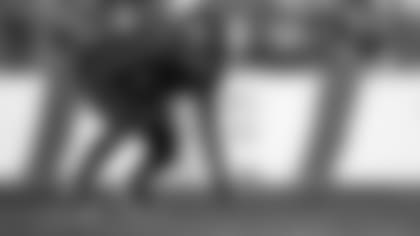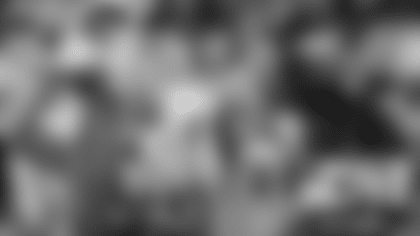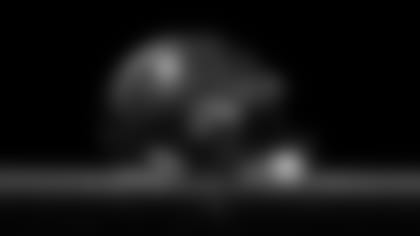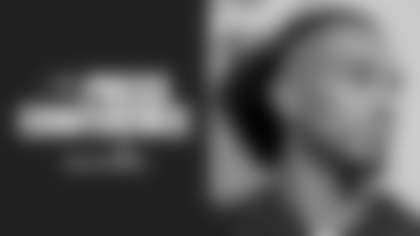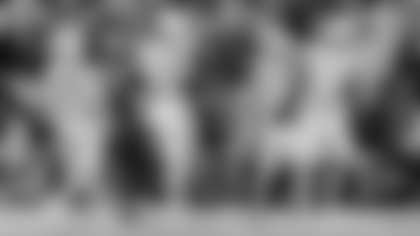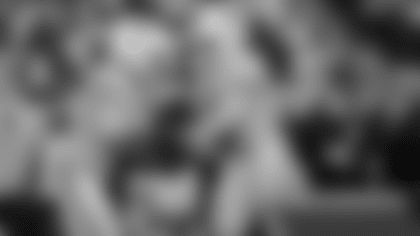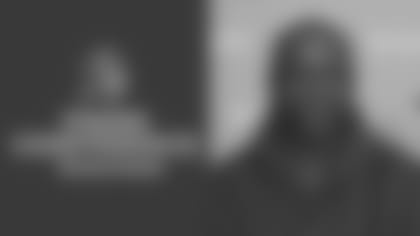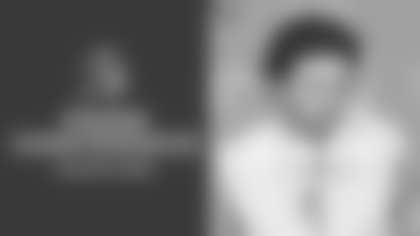Two moves made 165 days apart, two different knocks of opportunity answered, allowed the Tampa Bay Buccaneers to have a productive defensive end group in 2018. The Buccaneers will surely be looking for more opportunities to improve that important position in 2019.
The first opportunity came from the New York Giants, who were willing to trade productive veteran pass-rusher Jason Pierre-Paul, likely for cap reasons as they attempted to retool a roster that had bottomed out at 3-13 the year before. The Bucs landed the former University of South Florida star on March 22 for the reasonable price of a third-round draft pick and a favorable swap of fourth-round selections.
The second opportunity arose just before the start of the regular season when the Cleveland Browns somewhat surprisingly cut third-year defensive end Carl Nassib. The Bucs nabbed Nassib with a waiver claim on September 3 and he was a part of the D-Line rotation by the opening game six days later.
Pierre-Paul and Nassib combined for 19 sacks in 2018 and finished first and second in that category on the Bucs' roster. Tampa Bay's defense improved from a league-low 22 sacks in 2017 to a respectable 38 in 2018, and the difference came almost completely from the edges. Buccaneer defensive ends combined for 8.5 sacks in 2017 and 22.5 in 2018, and all but one of those 22.5 came from newcomers to the roster.
Pierre-Paul and Nassib figure to return as starters and the Bucs will hope to get a similar level of production out of those bookends, but the team could also easily add to that position in a draft loaded with talented pass-rushers. Those ends will also be under the direction of a new coaching staff and working at the behest of a new and aggressive play-caller in coordinator Todd Bowles. The Bucs got improved production from their line last year but still need to apply pressure on opposing quarterbacks more consistently.
That's the overall goal for the Buccaneers defensive ends/edge rushers (the possibility of more 3-4 scheming means there could be some new position designations on the depth chart), but each player in that unit will also face some specific questions of their own. With free agency set to begin next week, we are wrapping up our Burning Questions series, in which we've gone position by position and proposed one burning questions for each player on the 2019 roster. We did the offensive positions first: tight ends, wide receivers, running backs, offensive line and finally the quarterbacks. Now, having previously run through the safeties, cornerbacks, linebackers and defensive tackles, we finish our survey by looking at the defensive ends.
As will be the case at every position, we are only including players who are currently under contract for 2019, or could have tender offers as restricted and exclusive rights free agents. For the pending unrestricted free agents, obviously, the burning question that must be answered first is, 'Will they be back?'
One Burning Question for Each Buccaneer: Defensive Ends
Players under contract for 2019: 8 (Hunter Dimick, Will Gholston, Demone Harris, Farrington Huguenin, Carl Nassib, Patrick O'Connor, Jason Pierre-Paul, Noah Spence)
Potential unrestricted free agents: None.
Potential restricted free agents: None.
Potential exclusive rights free agents: None.
**
Hunter Dimick, Farrington Huguenin: Can they make the jump from practice squad experience to regular-season action?
Throughout this series we have occasionally grouped two or more players together if their situations are very similar. That's the case with these two young ends still searching for their first regular-season game exposure. Huguenin arrived in Tampa two weeks before Dimick and also got to the NFL a year earlier, but their NFL journeys so far are very similar.
Huguenin signed as an undrafted free agent with Miami in 2016, Dimick with Jacksonville in 2017. Huguenin didn't end up on an NFL roster that year but landed in Pittsburgh in 2017 and spent most of the next two years on the Steelers' practice squad. When Pittsburgh released him late last year, the Bucs signed him to their practice squad for the last two weeks of the season. Dimick spent all of his first NFL year on the Jaguars' practice squad and went back to camp in Jacksonville last year but was not with a team in the fall after being waived in the final cuts.
Both Huguenin and Dimick signed with the Buccaneers right after the 2018 on reserve/futures contracts that would take effect in 2019. As such, they will presumably both get a shot to attend another NFL training camp and try to take that next step in their professional careers: A spot on a 53-man roster. That's a leap that a couple players like Isaiah Johnson and Mike Liedtke made last year after multiple seasons as practice-squad players, as both made the Bucs' opening day roster. Dimick and Huguenin will try to follow suit.
**
Will Gholston: Can he reverse the trend of his declining playing time?
The Buccaneers drafted Gholston in the fourth round in 2013 and he has since played six seasons for the team and has logged 48 starts. That's already a pretty good return for the investment of a fourth-round pick, and Gholston had steadily improved over his first four seasons to the point that the franchise was motivated to give him a new five-year deal after the 2016 season.
That new contract came on the heels of a campaign in which Gholston had started all 14 games in which he played, tied a career high with three sacks and been considered one of the team's very best defenders against the run that year. The return on Gholston's second contract, however, hasn't been as good. Yet.
During that fine 2016 season, which ended two weeks early due to a shoulder injury, Gholston participated in 64% of the team's snaps through the first 14 games. In 2017, the first year of his new deal, Gholston saw his starts dip to 10 and his playing time to 48% of the team's defensive snaps, and he didn't completely duplicate his success against the run from the year before. Last year, after the Buccaneers added a handful of new defensive linemen through free agency, the draft and the trade market, Gholston's playing time dipped further to two starts and 38% of the defensive snaps.
Gholston will turn 28 near the beginning of next year's training camp, and before last season he reworked his physique in an effort to regain his form from 2016. While that failed to come to fruition in 2018, Gholston still has time to work his way back into a bigger role on the Bucs' defense.
**
Demone Harris, Patrick O'Connor: Will spending essentially a full year developing on the Bucs' practice squad lead to bigger opportunities in 2019?
Again, we have two players whose key question for 2019 is essentially the same. On a 11-man practice squad that was tweaked on a near-weekly basis last year, with __ different players spending at least one week with that crew, Harris and O'Connor were fixtures throughout the 2018 season. O'Connor, in fact, joined tackle Cole Boozer as the only men to spend the entire season on the Bucs' practice squad, not including International Pathway Program player Eric Nzeocha. Harris began and ended his rookie season on that same unit, sandwiched around a month-long stint on the active roster.
O'Connor had previously spent about half of his rookie season, 2017, on Tampa Bay's practice squad, followed by five weeks on the active roster and three games in which he logged playing time. He was originally a seventh-round draft pick by the Detroit Lions.
So both Harris and O'Connor have already shown enough to warrant promotions to the 53-man roster at varying times. The Buccaneers figure to have a lot of moving parts in their defensive front in the months to come, with a new coaching staff bringing in a different scheme. Perhaps opportunity and a full year of NFL practice experience will combine to give Harris and or O'Connor a shot at making the active roster to start the season.
**
Carl Nassib: Can he continue to be a player on the rise and demonstrate that his 2018 season was a new baseline?
The Browns drafted Nassib out of Penn State in the third round in 2016. He seemed to have his career off to a fine start in Cleveland, playing in 30 games and starting half of those in 2016-17 and contributing a total of 5.5 sacks. That's usually enough to buy a third-round pick without an injury history at least another year, but the Browns chose to part ways with their third-year edge at the end of the 2018 preseason. Presumably the Browns, who had given their roster a talent infusion with a heavy dose of draft picks in recent years, simply believed they had better options in the likes of Myles Garrett, Emmanuel Ogbah and others.
The Buccaneers were happy to give Nassib a landing spot and his addition quickly proved helpful when Vinny Curry ran into some injury issues at midseason. Nassib started out as a rotational player getting about 25 snaps a game but then took over as the starter when Curry went down and stayed in that role when Curry returned. Nassib would finish the season with 6.5 sacks, second only to Pierre-Paul's 12.5, and he consistently provided a high-energy style of play that made the Bucs' edge rush a greater problem for opposing offenses.
Would the Browns have released Nassib if they knew he was going to produce a season of that caliber? Perhaps, but it surely would have been a tougher decision. Now that he's a valued member of the Buccaneers, the question is whether Cleveland cut a player who is going to consistently produce those types of results. Did Nassib set a new baseline for his career in 2018, from which he will now pursue double-digit sack seasons? The Bucs certainly hope so.
**
Jason Pierre-Paul: In his first season as a Buccaneer, Pierre-Paul recorded his first 10-sack season in four years and broke a long franchise drought in that category – but could he actually be better in 2019 with a bit better fortune in the injury department?
The Buccaneers sent a relatively valuable commodity to New York – a high third-round draft pick – to get Pierre-Paul, who was heading into his ninth NFL season. The reasoning behind the move was straightforward: Pierre-Paul was a proven productive pass-rusher and those are not easy to find in the third round of a draft.
After one season, that reasoning appears quite solid. Pierre-Paul had 12.5 sacks in his first Tampa Bay season – the first double-digit sack campaign by a Buc since Simeon Rice had one in 2005 – and indeed there were no third-round rookies who got even close to that. In fact, there wasn't a single rookie in 2018 who matched Pierre-Paul's sack total, though fifth-overall pick Bradley Chubb got close with 12.0. The Giants used the pick they got from the Bucs to draft defensive tackle B.J. Hill, who had 5.5 sacks, which is actually an impressive use of that resource. However, no player drafted at or after pick #69 had more than six sacks in 2018. Pierre-Paul doubled that.
The flip side of that argument, of course, is that the players drafted last year are quite a bit younger than Pierre-Paul, who turned 30 on New Year's Day and could contribute for a longer time and at a more controlled cost, at least those picks that pan out. The Bucs will truly feel good about their side of last year's trade if Pierre-Paul continues to produce at a high level for several more years.
Can that happen? Of course it can,but it's not guaranteed. Why should the Bucs be optimistic about Pierre-Paul's continued production? Well, there's a good chance JPP will have better luck with injuries in his second Buccaneer season. He was a fixture on the weekly injury report and during the course of the season was listed with a half-dozen different injuries, sometimes two or three at once. It was an impressive display of toughness – he was the only Tampa Bay defender to start all 16 games – but it's reasonable to believe the various ailments eventually slowed him down.
Pierre-Paul had at least one sack in six of the Bucs' first seven games and nine of the first 12. He had reached double-digits by 11 games and was sitting at 11.5 through three quarters of the season. He also had 19 QB hits in this first 12 contests. Through the last four games, however, Pierre-Paul had just one sack and one quarterback hit.
Pierre-Paul could also be better on a per-snap basis in his second Buc season, depending upon how deep the D-Line rotation proves to be. Though he didn't wantto play fewer snaps after leading all NFL defensive linemen in that category in 2017, the Buccaneers probably would have tried to get him a few more breathers if their expected rotation had worked out. Alas, it did not and Pierre-Paul played 933 snaps, or 89% of the Bucs' total.
**
Noah Spence: Will a new defensive scheme mean new life for a still-promising player whose role in the defense was marginalized in 2018?
At the NFL Scouting Combine last week, General Manager Jason Licht expressed the belief that a new defensive system schemed by Todd Bowles could "open new doors" for Spence. Assuming Spence heard those comments, they were likely music to his ears.
Spence was a high second-round pick in 2016. The Buccaneers had deep needs at cornerback and on the defensive line in that offseason and they chose to get the cornerback – Vernon Hargreaves – first with the thought they could still nab an edge-rusher like Spence in Round Two. Or not "like" Spence but specifically Spence, who had recorded 11.5 sacks in his final year at Eastern Kentucky after beginning his collegiate career at Ohio State.
The Bucs got their man and the results seemed promising when Spence started his NFL career with a 5.5-sack season despite dealing with an early-season shoulder injury that forced him to wear a harness most of the year. He couldn't overcome a second shoulder injury in 2017 and ended the year with just six games played and one sack. After the Buccaneers added a number of new linemen in the offseason, as noted above, Spence found himself barely hanging on to the fringe of the rotation. He was inactive or did not play in four of the first five games and never saw more than 11 defensive snaps in any one contest. That limited his 2018 output to four tackles and one QB hit.
So why should 2019 bring a new outlook for Spence after two lost years. It's simple: A new defensive scheme. Built more like an edge-rushing linebacker in a 3-4 front at 6-2 and 251 pounds, Spence might find himself on a team looking for that exact commodity. Bowles and Bruce Arians have said they will scheme around their players, and there are likely to be both 3-4 and 4-3 influences in the final product, but Bowles' defenses have generally identified as 3-4. It would be a stretch to assume that Spence will instantly become more productive if he's playing as a 3-4 linebacker rather than a 4-3 end, but it certainly seems like a reasonable possibility. It is, at the least, an open door for Spence to walk through in an attempt to get his career back on track.



